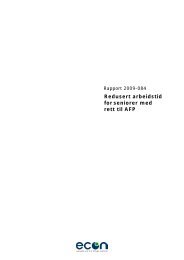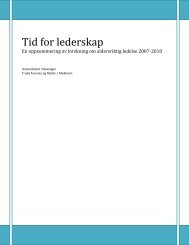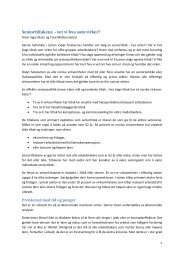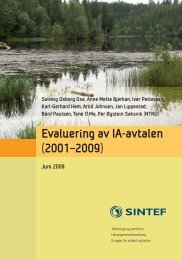Per Erik Solem
Per Erik Solem
Per Erik Solem
You also want an ePaper? Increase the reach of your titles
YUMPU automatically turns print PDFs into web optimized ePapers that Google loves.
<strong>Per</strong> <strong>Erik</strong> <strong>Solem</strong><br />
NOVA<br />
Norway<br />
Ageism and discrimination of older workers in Norway<br />
Objectives<br />
The concept of ageism is used in many different ways in the literature. A conceptual analysis<br />
done by Iversen, Larsen & <strong>Solem</strong> (2009) clarifies the dimensions and presents a new<br />
definition. The paper will present this definition and exemplify with empirical research on one<br />
dimension: explicit negative discrimination of older workers in Norway.<br />
Methods<br />
The empirical part is based upon the Norwegian Senior Policy Barometer for every year from<br />
2003 to 2009. Data for two barometers are collected each year, one barometer for employed<br />
persons in general (N= about 1000 each year, summing up to 7016) and one for managers (N=<br />
about 750 each year, summing up to 5309). Data are collected on national samples by the<br />
marked research institute Synovate for the Centre for Senior Policy.<br />
The questions:<br />
- How often have you had the experience that discrimination takes place in working life,<br />
because of a) Gender, b) Age? (very often / often / now and then / seldom / never)<br />
- How often have you had the experience that the following situations happen in working life?<br />
(very often / often / now and then / seldom / never)<br />
a) Older workers are passed over for appointments and internal recruitments<br />
b) Older workers are more seldom permitted to attend to courses and training during working<br />
hours<br />
c) Younger workers are preferred when new technology or new working methods are<br />
introduced<br />
d) Older workers receive less wage increase than younger workers<br />
- About how old would a qualified applicant to a position be before you hesitate to call him or<br />
her in for an interview, because of age?<br />
The questions ask about the experiences of the respondent, however not about the<br />
respondents' experience of being exposed to age discrimination themselves. The main reason<br />
for asking indirectly is that we wanted workers and managers to be asked the same questions.<br />
And since age discrimination is illegal, questions to managers on how often age<br />
discrimination takes place in their company, would be prone to underreporting.
Thus, the questions used are not measuring the prevalence of age discrimination. However, it<br />
is possible to compare age discrimination with sex discrimination. The questions also give an<br />
indication of the relative prevalence of different types of age discrimination and of possible<br />
changes during the study period.<br />
Results<br />
Iversen et al. (2009) refer to twenty-seven different definitions of ageism, which is used in the<br />
research literature. The definitions cover, to varying degrees, four dimensions:<br />
- The three classic components of attitudes: the cognitive (stereotypes), affective (prejudice)<br />
and behavioral (discrimination), - positive and negative ageism, - implicit and explicit ageism,<br />
- ageism on micro level (individual), meso level (e.g. intergroup segregation) and on macro<br />
level (e.g. legislation on mandatory retirement).<br />
Ageism is defined as negative or positive stereotypes, prejudice and/or discrimination against<br />
(or to the advantage of) elderly people on the basis of their chronological age or on the basis<br />
of a perception of them as being 'old' or 'elderly'. Ageism can be implicit or explicit and can<br />
be expressed on a micro-, meso- or macro-level.<br />
The results from the Norwegian Senior Policy Barometer show only small changes from 2003<br />
to 2009. Changes are statistically significant for managers, but not for the age group of<br />
workers susceptible for discrimination, the seniors 55 years and above. In 2009 managers<br />
report less age discrimination than in 2003, while the seniors have observed no change.<br />
Managers have over the whole period lower estimates than senior workers, of how often they<br />
have observed that age discrimination takes place. For example, in 2009 23 per cent of the<br />
managers say they at least now and then have experienced that older workers are passed over<br />
for appointments and internal recruitments, compared to 35 per cent of seniors saying the<br />
same. For one question, that younger workers are preferred when new technology or new<br />
working methods are introduced, managers have more negative estimates than seniors. In<br />
2009, 58 per cent and 52 per cent of mangers and seniors respectively report this to happen at<br />
least now and then. The difference is small, but probably seniors themselves often have low<br />
confidence in their ability to use new technologies.<br />
Conclusions<br />
When studying ageism and age discrimination it is of great value to be clear on what<br />
dimensions of ageism are included in the study. The empirical part of this paper study the<br />
behavioral part of attitudes; age discrimination, and show small changes over the study<br />
period. Managers estimate discrimination of older workers to happen less often than do<br />
seniors.<br />
(Further analyses will expand on conclusions)
















